It was supposed to be an expedition that would confirm British domination on the oceans. The Arctic expedition of the ships Erebus and Terror was followed with bated breath. It turned out, however, that there will be no happy ending. Two ships with over a hundred sailors were lost in the Arctic ice. A cruel truth, long refused to accept, was only confirmed 140 years later. Hungry and lead-poisoned polar explorers ate their companions to survive ...
The expedition, whose purpose was to discover the Northwest Passage, and thus break through the Arctic Archipelago north of Canada from the Atlantic to the Pacific Ocean, set off in 1845. The British Navy put Capt. John Franklin - an experienced sailor and polar explorer - great hopes.
After years of unsuccessful attempts to explore the Arctic, it was finally going to be successful, and Britain would be the first to "put a hand" on a new route that would guarantee a shorter trip to Asia and thus economic success. Care was taken that the expedition was well prepared. The ships Erebus and Terror were equipped with the most modern then steam engines from the British railways. The units also had steam central heating and even something for the spirit. So that the sailors would not get bored and not lose faith, the Erebus had a piano, a library, and a daguerreotype camera - an unquestionable hit of the technology of that time.
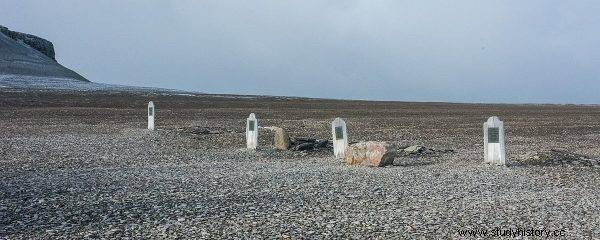
Tombs on Beechey Island
A dozen or so tons of provisions were also taken, which was to be enough for a few years. Since the real bane of the sailors of those times was scurvy, caused by a vitamin C deficiency in the diet of people who stayed at sea for many months, the lime juice used by the British navy at that time was taken care of, which was to provide the participants of the expedition with a substance essential for health.
There were also more than 8,000 cans of the most modernly packaged meat on the ship, namely canned goods, which were viewed as a healthy, non-perishable source of food. Owen Beattie and John Geiger, authors of the book "Forever in Ice" about Franklin's expedition, which is also a report on a later investigation into the causes of the tragedy, write:
Nutritional innovation very quickly gained acceptance of the Admiralty, which was convinced of the powerful anti-scurvy properties of the new invention. (...) Before metal canned food with meat and vegetables appeared in 1810, all previous sea expeditions were reliant on packed provisions that could be stored for a long period:salted beef and pork, rusks, pemmikan and flour. But such food not only did not protect against scurvy, but also deteriorated quickly, which was largely due to the insects and rats in it.
After more than a century, in 1986, the bodies of the victims of Terror and Erebus were examined again by a group of scientists from the University of Alberta. They took samples from the bodies of sailors who died in the early stages of the expedition. The study found that young men died of pneumonia and tuberculosis, but all were heavily lead poisoned. The concentration of this substance exceeded the permissible limits by several thousand percent.
A cruel truth has also emerged. Scientists have confirmed the reports of nineteenth-century searchers of the Franklin crew, who learned from local Inuit that during a dramatic march towards the Canadian border, white people ate each other ...
Madness in the dark
The expedition set out on the morning of May 19, 1845 from Greenhithe, England, with 24 officers and 110 crew members. Although Cpt. Franklin and the commander of Terror, Capt. Francis Crozier were experienced polar explorers, most of the crew made up of novices who ventured into the kingdom of ice for the first time. It was a big mistake.
These people experienced firsthand how dangerous this barren, though specifically beautiful, land with huge icebergs is. In conditions of extreme cold, darkness of the polar night, crammed into a small space, additionally limited by tons of provisions, without the possibility of sufficient hygiene among the dirt and rats, the crews crammed under the deck had to endure the most difficult time - the months of arctic winter when ice-bound ships could not sail.
In a time when there were no icebreakers, this was how to conquer the Arctic. Subsequent expeditions expected that the glaciation of the straits between dozens of islands in the archipelago would immobilize their ships for many months, which would have to be waited below deck.
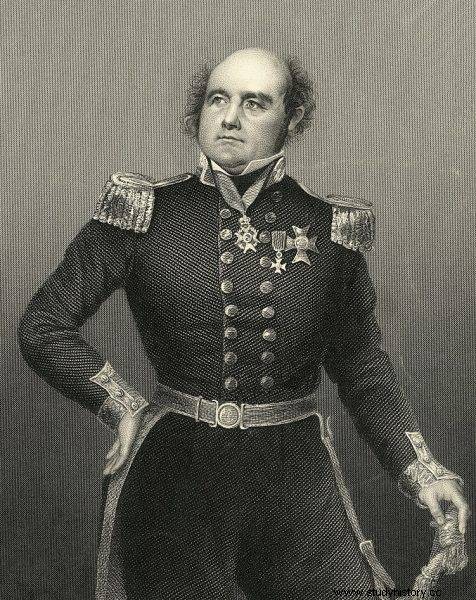
Sir John Franklin, Expedition Commander
No account of Franklin's expedition has survived (apart from two brief notes), but the sailors must have had the same experience as the members of the search teams that left shortly after Erebus and Terror did not return home. The ship's physician of the 1850 rescue expedition recalled the conditions on the ship as follows:
Thirty-three heavily dressed men are crowded into a small space smaller than the father's library. One of them is me. Three stoves, a stove in a galley, three lamps burning bear fat burn all the time like in the temple of Vesta. Damp fur, dirty woolen clothes, worn shoes, sick people, food, tobacco smoke, digestive effects, they all create fumes surrounding me and encroaching on me. Hour after hour, day after day, no bunk to rest on or blanket curtains to hide behind. It all adds up to the reality of my present home.
The Doctor added increasingly visible signs of exhaustion and mental aberrations in the crew members.
Rats everywhere
Owen Beattie and John Geiger write:
In this atmosphere of depression, the first symptoms of scurvy appeared in September. As Christmas arrives, many people are short of breath, and officers notice a strange phenomenon, also previously noted by British polar explorers, the "indefinite hunger" for animal fat.
Kane describes the "strange waxy pallor" and even "spooky" faces of the expedition members. People say they have very vivid, bizarre dreams. One says, for example, that he found "Sir Franklin in a beautiful bay lined with orange trees." Another dreamed that he walked nearby to the empty and lifeless shore of the island and "came back loaded with watermelons".
The rats were also the curse of the sailors. Elisha Kent Kane, an officer in the US Navy, had to contend with rodents as the commander of the Advance ship during the Franklin search expedition in 1853–1855. In his notebook he wrote:
They are everywhere (...) under the stove, in cabinets, in pillows, running around the bunks. If I were asked about the three worst plagues after the dark, cold and scurvy that fell on us while in the Arctic, I would have replied without hesitation:RATS, RATS, RATS. (...) It is impossible to keep anything under deck anymore. Furs, woolen clothes, shoes, collected nature specimens, everything that we would not want to lose, although it has little value to them, have been eaten and destroyed.
Trapped in ice
The first winter, the ships waited chilled in ice near Beechey Island. Three crew members are buried here. The oldest was just over 30 years old. A research on the corpse from the 1980s showed that all of them were heavily poisoned with lead, scurvy, pneumonia, tuberculosis.
After the first winter, when the ice had melted a bit, Erebus and Terror continued their cruise deep into the Arctic Archipelago. In 1846, ships sailed towards the Peel Strait and King William Island - and it was there that the Arctic claimed the daredevils who tried to wrest its secret.
Erebus and Terror were immobilized by the ice pressing from everywhere. Ships, specially strengthened before leaving Great Britain (frames were strengthened with massive beams and iron covering, the iron cover was to protect the screws and rudders), turned out to be helpless in the fight against the elements. The ice crushed, broke the structure, masts, steam propulsion elements. It quickly turned out that the wonders of British technology were not fit for further navigation.

Commander F.R.M. Crozier, captain of HMS "Terror", later leader of the expedition
In such circumstances, Capt. Franklin - even before there were more than a hundred people left, made a desperate attempt to save lives. It is not known what caused the death of the leader of the expedition. The news of the death of Franklin, who was treated like a celebrity in Victorian England, only came to light 13 years after the expedition as King William Island was being searched by another team, sent on the initiative of the non-winners of Lady Franklin, the wife of Captain Erebus.
The expedition led by Francis MacClicktok found a mound on the island. At that time, such structures were put up by polar explorers, in order to leave a message to other teams - about their position, the course of the expedition, etc. This was also the case this time.
Two pieces of news were found inside - good and bad. Until the summer of 1846, after the first Arctic winter, the expedition went smoothly. "It's okay," said the note. The second message, however, was much worse. On April 25, 1848, it was recorded that Erebus and Terror had been trapped in the ice for a year and a half and that the crew had left the ships on April 22. . Commanding Capt. Franklin had been dead for a long time. According to the memo, he died on June 11, 1847. In addition to him, 24 crew members and officers were killed.
Lunch with a friend
More than a hundred sailors led by John Crozier made a dramatic attempt to save lives. The exhausted, seriously ill, weakened people put what was needed and had some value on a sledge and set off on a death march - the nearest white man settlement was two thousand kilometers from King William Island. Successive expeditions in search of missing sailors (and there were several dozen of them), collecting abandoned belongings and the bones of the dead, revealed the terrible truth about the fate of the sailors. It was passed on to seekers by the Inuit, that is, the indigenous inhabitants of these lands.
They mentioned that at the end of the march the white people "ate each other". Such news, confirmed by finds consisting of sawn and crushed human bones, was brought to Britain by, among others John Rae - commander of the 1855 expedition. He reached the Inuit who told of the deaths of more than 40 whites dying near the mouth of the Back River.
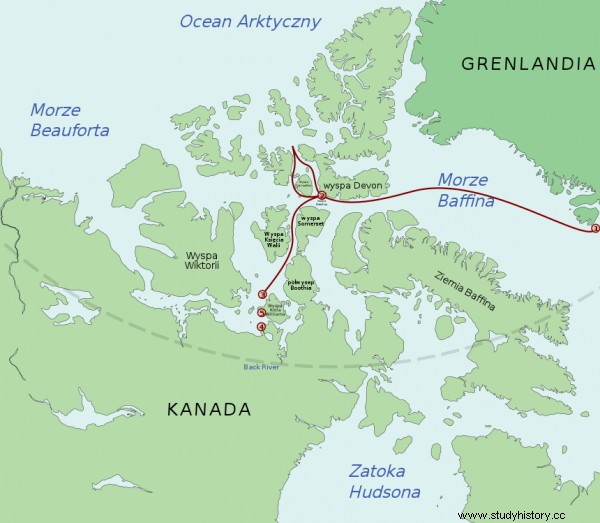
Map of Franklin's last expedition.
1. stop at Disko Bay, July 1845. 2. Wintering on Beechey Island, 1845/46 3. Ships trapped in ice, from 1846 4. HMS Erebus wreck, found in 2014
5. HMS Terror wreck, found in 2016
Subsequent reports of cannibalism provoked resistance and outrage among the British. Society was not ready for the cruel truth about the last moments of those in which it had such high hopes. The participants of the expedition were defended by officials and respected people of the world of culture - incl. Charles Dickens, who publicly attacked the Inuit in the press:
We argue that the memory of these lost Arctic travelers, by mere reason and experience, ranks much higher than the slanderous slander of such haphazardly allowed connections, and that the noble conduct and example of these people and their great leader in similar pre-existing circumstances contradict, outweighing in their weight, the whole universe the chatter of a coarse handful of uncivilized men who feed on blood and whale fat.
With subsequent expeditions, however, it was impossible to deny the macabre truth in the long run. The authors of the book Forever in Ice. In the footsteps of John Franklin's tragic expedition ”they write:
Fifteen years later, Rae got confirmation of his information from Charles Francis Hall, who had also heard reports of cannibalism from the Inuit and presented it in much more detail. Even today these relationships are terrifying. The Inuit reported that they found shoes "reaching to the knees, and in some of them cooked human flesh." Hall wrote: Some bones were sawed off; holes were punched in some of the skulls ” . In other corpses found nearby the camp, all the tissues were carefully separated from the bones, "as if someone had cut them off to eat them".
Findings made by the 19th century explorers were finally confirmed in the 1980s. The research team that exhumed the bodies of sailors who died in the first part of the expedition also examined the remains of scattered human bones on King William Island. They were broken, cut and sawn. They remained a silent trace of the drama of people who - in order to save lives - broke the taboo, committed actions beyond the margins of humanity.
Death from canned food
As early as in the 19th century, participants of expeditions to the Arctic region mentioned the surprisingly rapid progress of the "seafaring" disease, i.e. scurvy, despite the fact that preventive measures were taken to prevent the drastic deficiency of vitamin C. of these fruits.
However, the sailors in the Arctic were losing strength very quickly, they became dull, terribly pale, and there was also a complete mental disorder. The participants of the expeditions fell into changing moods, neurotic and paranoid states. The possibility of a rational assessment of the situation, as well as intellectual abilities in such a situation decreased drastically. Today we know that it was not about - similar in symptoms - scurvy, but about lead poisoning.
But where does lead come from in the organisms of seafarers? At the end of the nineteenth century, the British admiralty realized that it could come from a modern, hermetic method of packing meat, that is ... canned food. In those days, canned food was soldered both inside and outside with a thick layer of lead. This in itself was dangerous, and sometimes the solder, if not applied correctly, got into the meat.
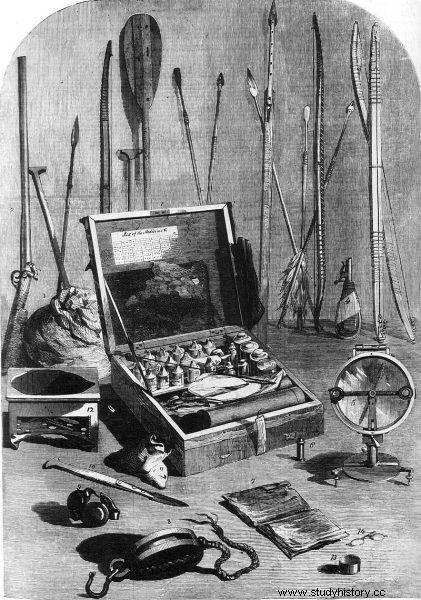
Missing Expedition Artifacts Found by McClintock
It was not until the 1880s, after George Washington de Long's tragic expedition to the Arctic, that the unfortunate canned food was linked to the miserable fate of seafarers. The commander of the expedition regularly kept a diary, which was found after the death of him and all other participants of the expedition. In it he noted:
June 1 [1881] Wednesday. - What's next? The doctor informs me this morning that he thinks several of the crew he is treating have had lead poisoning. (…) At first we suspected water (...). Then I thoroughly checked all the vessels in which we store or carry water, or we make coffee or tea, and decommissioned all the vessels where February was, and replaced them with enameled iron vessels.
However, when we looked at our tomatoes, we saw traces of lead present in more abundance than in the water, and the doctor thinks it is an annoyance to the crew, if I can call it that , is caused by a high consumption of this vegetable. Tomato acid reacts with tinned solder and forms a dangerous compound , (...). Now it dawned on us that the flight attendant, who is in the worst condition, likes tomatoes very much and has never denied them (...) .
Ice Trap
Lead may also have killed the sailors of Erebus and Terror. A team of scientists who studied the corpse in the 1980s confirmed that the concentration of this element was exceeded several dozen times in the bodies of three sailors buried at an early stage of the expedition.
The fate of the Arctic conquerors must have been a nightmare incarnate. Unable to come to terms with their own, increasingly weaker organisms, unable to sleep in the dark, they went maddening, being on the ship in an ice prison for much of the year . With the end of the poisonous canned food, they decided to abandon the ships and a march that could not be successful. At that time, their darkest instincts had awakened. Owen Beattie and John Geiger, authors of "Forever in Ice" write:
The story of how the Royal Navy lost the Battle of the Northwest Passage is actually the story of how the greatest naval forces of the world at that time were finally defeated by an uncomplicated yet terrifying disease caused by a vitamin C deficiency coupled with a health risk that no one else had a clue about at the time:lead.
The source of the British polar explorers' defeat was not the sea, freezing cold, arctic night that stretched for months, a labyrinth of straits and bays or a soul-killing cut-off from the world. This source was hidden in their provisions because they relied (and died) on canned food.
Interestingly, the arctic expeditions of the nineteenth century were kept alive by those sailors who acted exactly like the local Inuit - and therefore ate raw meat of salmon, carbiu and other Arctic animals. It turned out that this was the key to meeting the body's needs and supplementing the deficiencies of vitamins.
This is what John Ross, the first explorer to locate the magnetic north pole, did. During an expedition in 1830, ordered his people to eat what the natives instead of canned food coming to the conclusion that "the secret to surviving in these frost lands is to eat plenty of animal oil and fat" . The authors of "Forever in Ice" write:
From his contacts with the natives, he concluded that fresh meat, which was the main component of their diet, had anti-scurvy properties, and noted that "the local people cannot live without while alive on a less abundant diet, they get sick and die ”. He even wrote in the ship's journal:"The first salmon this summer was a medicine that cannot be replaced by any drugs on board."
Epilogue
Today, some scientists question the dominant influence of lead on the Erebus and Terror catastrophe. Recent studies indicate malnutrition, in particular zinc deficiency in the diet of seafarers, resulting from the lack of fresh meat. Is this the root of the tragedy in the Arctic ice or are there several factors at work?
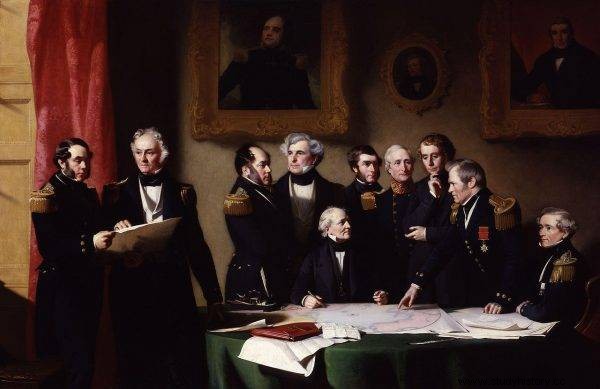
Arctic Council planning the search for John Franklin in an 1851 painting by Stephen Pearce
In 2014, thanks to the latest research methods, it was possible to locate the Erebus wreck. The ship is 11 meters deep in icy waters at the entrance to the Victoria Strait. Two years later, Canadian scientists located the Terror wreckage at a depth of 24 meters. Interestingly - contrary to the hypothesis that both ships were completely destroyed by ice, they were preserved in good condition, along with the equipment inside. Adrian Schimnowski, director of the Arctic Research Foundation, in an e-mail sent to the press from the board of the research unit "Martin Bergmann" wrote:
two bottles of wine, tables, empty shelves and a desk with open drawers. In one of them there is an undefined item. Similar exploration gives a partial answer to the question of what life was like on a ship 170 years ago.
Researchers found that the Terror was going slowly to the bottom. The ship, although the damage was visible (broken masts), at the same time gave the impression of being prepared for the winter. “All hatches are tightly closed and all kinds of equipment is in place. Three of the four aft windows also survive and are in place intact! I dare say that if the wreckage was lifted and the water pumped out of it, the ship would float "- added Schimnowski.
We managed to explore the mess, the food locker and the room where the dishes were kept. The coverings of the ships indicate that their final moments, as well as their positions, were different than originally anticipated. One thing is certain - despite the discovery of Erebus and Terror, the tragic expedition from 176 years ago still holds many secrets.
Source:
This article is based on the book by Owen Beattie and John Geiger, "Forever in the Ice. In the footsteps of John Franklin's tragic expedition ", Jagiellonian University Publishing House 2021.
